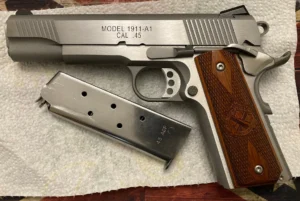The 1911 pistol is an iconic firearm that has earned its place in history as one of the most beloved handguns ever made. Designed by John Browning and first introduced in 1911, this pistol has seen service in the hands of military personnel, law enforcement officers, and civilian shooters alike.
Its reliability, accuracy, and powerful .45 ACP cartridge have made it a favorite among gun enthusiasts for over a century. However, one question continues to spark debate: Is the 1911 too heavy for modern use?
The 1911’s weight, typically ranging between 39 and 42 ounces when unloaded, is often cited as both a strength and a weakness. For many shooters, the heft of the 1911 is a key part of its appeal. The solid, all-metal construction gives the pistol a sense of durability and stability that many polymer-framed guns lack.
This weight also plays a significant role in managing recoil, especially when firing the .45 ACP round. The heavier frame helps absorb the recoil, making the 1911 more comfortable to shoot, particularly in rapid-fire scenarios.
On the other hand, some shooters find the 1911’s weight to be a drawback, particularly when it comes to everyday carry (EDC).
Modern concealed carry practices often favor lightweight, compact pistols that are easier to carry for extended periods. In this context, the 1911 can feel cumbersome, especially when compared to newer designs that weigh significantly less and offer higher ammunition capacity. The rise of polymer-framed pistols, which often weigh 25 ounces or less, has led some to question whether the 1911’s weight is a disadvantage in today’s market.
Despite these concerns, many 1911 enthusiasts argue that the pistol’s weight is not only manageable but also beneficial in certain situations. For those who prioritize accuracy and control over lightweight portability, the 1911 and its variants remain a top choice.
The pistol’s weight contributes to its legendary accuracy, making it a preferred firearm for target shooting, competition, and home defense. The stability provided by the 1911’s mass allows for more precise shots, particularly when firing rapidly or under stress.
Furthermore, the 1911’s design and balance mitigate some of the perceived drawbacks of its weight.
The pistol’s slim profile and ergonomics help distribute its weight evenly, making it more comfortable to carry than its size might suggest. Many shooters find that with the right holster and carry method, the 1911 can be a practical option for concealed carry, despite its heavier frame.
It’s also worth noting that the 1911’s weight has not deterred manufacturers from continuing to produce and innovate on this classic design. Numerous modern 1911 variants have been introduced, some with lighter materials like aluminum or scandium frames to reduce weight while retaining the pistol’s traditional characteristics.
These options offer a compromise for those who appreciate the 1911’s features but prefer a lighter firearm for carry purposes. Moreover, there are also a wide range of 1911 build kits available on the market that can be used to customize the experience of this legendary firearm.
In the end, whether the 1911 is too heavy depends largely on individual preferences and intended use. It is one of the best 45 ACP pistols of all time. For some, the weight is a critical factor that makes the 1911 less suitable for daily carry, especially when compared to more modern, lightweight pistols. For others, the weight is a defining feature that enhances the shooting experience, providing greater control, accuracy, and a sense of confidence in the firearm’s reliability.
The 1911’s longevity and continued popularity suggest that, despite its weight, it remains a viable and cherished option for many shooters. Its timeless design, coupled with its proven performance, ensures that the 1911 will continue to hold a place in the world of firearms for years to come. Whether you view its weight as a burden or a benefit, there’s no denying that the 1911’s legacy is built on more than just its mass—it’s a testament to its enduring quality and the skill of its designer.




